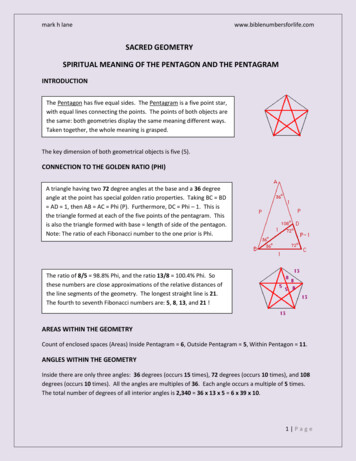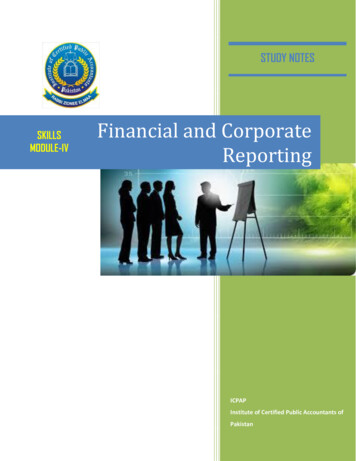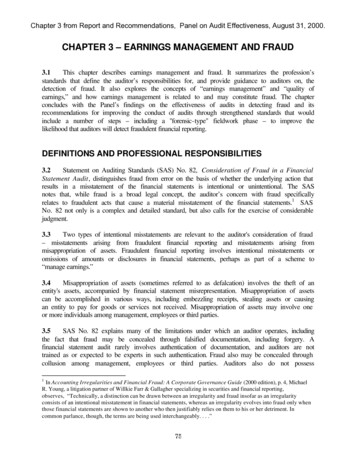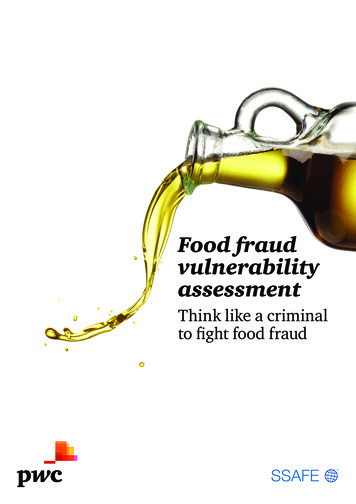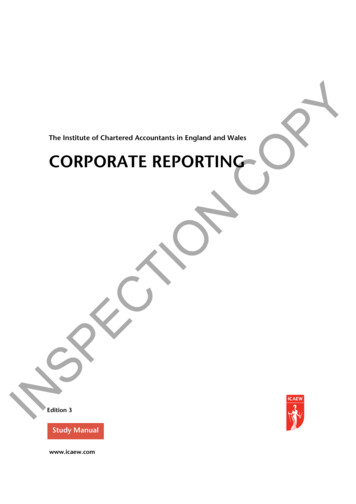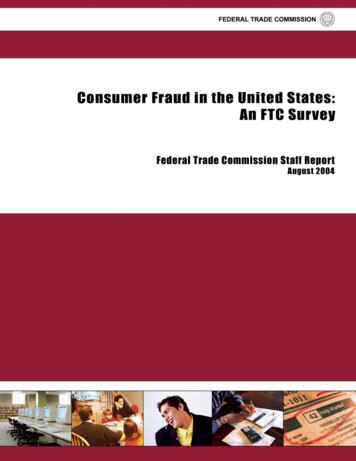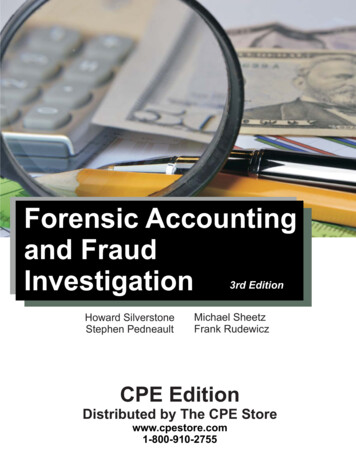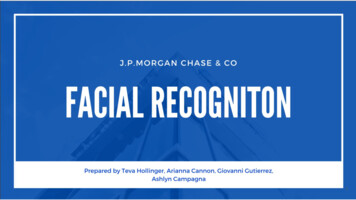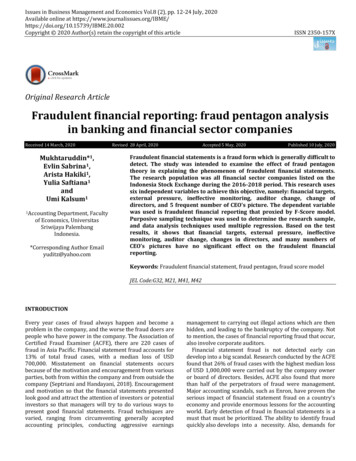
Transcription
Issues in Business Management and Economics Vol.8 (2), pp. 12-24 July, 2020Available online at /10.15739/IBME.20.002Copyright 2020 Author(s) retain the copyright of this articleISSN 2350-157XOriginal Research ArticleFraudulent financial reporting: fraud pentagon analysisin banking and financial sector companiesReceived 14 March, 2020Mukhtaruddin*1,Evlin Sabrina1,Arista Hakiki1,Yulia Saftiana1andUmi Kalsum11AccountingDepartment, Facultyof Economics, UniversitasSriwijaya PalembangIndonesia.*Corresponding Author Emailyuditz@yahoo.comRevised 28 April, 2020Accepted 5 May, 2020Published 10 July, 2020Fraudulent financial statements is a fraud form which is generally difficult todetect. The study was intended to examine the effect of fraud pentagontheory in explaining the phenomenon of fraudulent financial statements.The research population was all financial sector companies listed on theIndonesia Stock Exchange during the 2016-2018 period. This research usessix independent variables to achieve this objective, namely: financial targets,external pressure, ineffective monitoring, auditor change, change ofdirectors, and 5 frequent number of CEO's picture. The dependent variablewas used is fraudulent financial reporting that proxied by F-Score model.Purposive sampling technique was used to determine the research sample,and data analysis techniques used multiple regression. Based on the testresults, it shows that financial targets, external pressure, ineffectivemonitoring, auditor change, changes in directors, and many numbers ofCEO’s pictures have no significant effect on the fraudulent financialreporting.Keywords: Fraudulent financial statement, fraud pentagon, fraud score modelJEL Code:G32, M21, M41, M42INTRODUCTIONEvery year cases of fraud always happen and become aproblem in the company, and the worse the fraud doers arepeople who have power in the company. The Association ofCertified Fraud Examiner (ACFE), there are 220 cases offraud in Asia Pacific. Financial statement fraud accounts for13% of total fraud cases, with a median loss of USD700,000. Misstatement on financial statements occursbecause of the motivation and encouragement from variousparties, both from within the company and from outside thecompany (Septriani and Handayani, 2018). Encouragementand motivation so that the financial statements presentedlook good and attract the attention of investors or potentialinvestors so that managers will try to do various ways topresent good financial statements. Fraud techniques arevaried, ranging from circumventing generally acceptedaccounting principles, conducting aggressive earningsmanagement to carrying out illegal actions which are thenhidden, and leading to the bankruptcy of the company. Notto mention, the cases of financial reporting fraud that occur,also involve corporate auditors.Financial statement fraud is not detected early candevelop into a big scandal. Research conducted by the ACFEfound that 26% of fraud cases with the highest median lossof USD 1,000,000 were carried out by the company owneror board of directors. Besides, ACFE also found that morethan half of the perpetrators of fraud were management.Major accounting scandals, such as Enron, have proven theserious impact of financial statement fraud on a country'seconomy and provide enormous lessons for the accountingworld. Early detection of fraud in financial statements is amust that must be prioritized. The ability to identify fraudquickly also develops into a necessity. Also, demands for
Issues Bus. Manage Econ.13financial reporting that are increasingly comprehensiveafter the enactment of the International Financial ReportingStandards for the last five (5) years, also do not guaranteeto be able to reduce the opportunity for fraud in financialreporting. With the more comprehensive financialstatements that must be presented by management, thereare many gaps in the financial statements that open upopportunities for unscrupulous management to commitfraud through earnings management.In practice, fraud does not only occur in manufacturingcompanies. Many financial and banking sector companiesalso experienced it. Based on a survey conducted by theIndonesian Chapter ACFE in 2016, it shows the fact that thefinancial and banking sector is the sector that experiencedthe most cases of fraud after the government sector. Theresults of a survey conducted by the ACFE are also evidentfrom banking and financial companies in Indonesia, whichuntil now, are still vulnerable to cases of fraud. Fraud thatoccurred in the financial and banking sector in Indonesia isalso not a new thing anymore. In 1997, Lippo Bankreported that the company was at a loss with assets smallerthan the actual value of the asset. An example of a fraudscandal in the Indonesian financial and banking sector,which until now has not been completely resolved and isstill being discussed, is the fraud that occurred at CenturyBank, which was reportedly also dragged the names ofexecutives in Indonesia.In general, fraud will always happen when there is noprior prevention and detection. In addition, the preventionand detection of fraud in financial statements also oftencollides with the presence of other factors that motivate theemergence of fraud in various situations, as explained byvarious theories of fraud such as Cressey’s Fraud TriangleTheory, Wolfe's Fraud Diamond Theory and most recently,Crowe’s Pentagon Theory Fraud. To Crowe (2011),Pentagon Theory has five fraud risk factors that usefinancial and non-financial ratios. Five fraud risk factorsconsist of pressure, opportunity, rationalization,competence, and arrogance. Pentagon Fraud is a newtheory that explores more on the trigger factors of fraud ispentagon fraud.The competencies described in the pentagon fraud theoryhave the meaning which is similar to capability previouslydescribedinthediamond fraudtheory byWolfe&Hermanson (2014). Competence/capability is theability of employees to ignore internal controls, develophiding strategies, and control social situations for personalbenefit (Crowe, 2011). To Crowe, arrogance is an attitude ofsuperiority over the rights held and feels that internalcontrols or company policies do not apply to him.Moreover, fraud doers now tend to have a moreindependent mindset, more adequate information andaccess, compared to the era of fraud triangle (Marks, 2012).The behavior and reasons or motives of management tocommit fraud in financial statements are mostly explainedin fraud theory. Pressures faced by management as agentsfor investors such as pressure to improve performance orincrease the value of the company on the stock exchange,for example, can also be used as a kind of rationalization formanagement to manipulate financial statements. Especiallyif the opportunity to commit fraud, it is also a small risk tobe detected. Opportunities will be the entry point for fraud,while pressure and rationalization will encouragemanagement to commit fraud. However, fraud withcomplex techniques and a large nominal is not possible ifthere is no particular person with special capabilities in thecompany. In other words, people who commit fraud musthave the capability or competence to fool the internalcontrol, control the situation, and develop strategies todisguise fraud. Feelings of superiority and arrogance withpositions held, coupled with greed, make the perpetratorsconfident that internal control does not apply to them.Earning management practices are a form ofmanipulation of financial statements that are often chosenas short-term 'solutions' by management to maintaininvestor confidence in their performance (Yendrawati et al.,2018). Earning management is a phenomenon that isdifficult to avoid because of the use of accrual basis inpreparing financial statements. Earnings management canmake a company's performance look better than itscompetitors so that investors who are not careful(inattentive investors) will be easily deceived bymanagement. Septriani and Handayani (2018) posited thatearnings management is the beginning of financialstatement fraud because financial statement fraud is oftenpreceded by misstatements or earnings management fromquarterly financial statements that are consideredimmaterial, but eventually develop into large-scale fraudand produce reports financially materially misleading.Several studies have been conducted to see howpentagon fraud can detect the fraudulent financialreporting (Antawira et al., 2019; Apriliana and Agustina,2017; Septriani and Handayani, 2018; Ulfah et al., 2017).Antawira et al. (2019) found that the financial target canaffect the tendency of fraudulent financial reporting. Butother studies show different results, Husmawati et al.(2017) conclude that financial target has not influence grum (2017) found that external pressure affectfraudulent financial reporting, meanwhile Apriliana andAgustina (2017) did not find the relationship betweenexternal pressure and fraud. Research conducted by Ulfahet al. (2017) show that auditor opinion has effect onfraudulent financial reporting.There has been no consistency from the results of theabove research that caused this research to be stillinteresting and relevant to be studied. In addition, theopposite results of the variable above give the authorattention to reexamine whether the pentagon fraud theoryis able to detect fraudulent financial reporting.This study is different from previous studies, namely interms of the dependent variable measurement model used.The measurements used for the dependent variable in thisstudy use the measurement model F-score proposed byDechow et al. (2012) for detecting fraudulent financialstatements that are analyzed by Pentagon Theory Fraud.
Mukhtaruddin et al.14Figure 1: Crowe’s Fraud PentagonSource: www.researchgate.netThis model detect earnings management thatsimultaneously improves test power and specification(Dechow et al., 2012). The variable component of the FScore includes two things that can be seen in financialstatements, namely accrual quality, and financialperformance. Based on Kothari and Leone (2001),performance-matched discretionary accruals are morespecific and powerful measurements than otherdiscretionary accruals. Kothari and Leone (2001) alsoexplained that performance matching is designed to controlthe impact of performance in measuring discretionaryaccruals and performance-matched discretionary accrualscan be used as an alternative that can be used inresearching earnings management. Based on thebackground above, the author finally decided to conduct aresearch entitled “Fraudulent Financial Reporting: FraudPentagon Analysis in Banking and Financial SectorCompanies”.Fraudulent financial reporting not only causes thedeclining in the ethical value of the accounting profession,but also causes financial losses with a sizable amount(Antawira et al., 2019). The role of the auditor profession inthis issue is very important for early detection andprevention of the possibility of fraudulent financialreporting so as to minimize the emergence of prolongedproblems. To Crowe (2011) the factors causing fraud actsconsist of five elements, namely: pressure, opportunity,rationalization, competence, and arrogance. The fiveelements are more commonly known as Crowe’s fraudpentagon theory.Literature review and hyphotesis developmentTheory of Fraud PentagonThe first theory put forward by Cressey (1953), whichexplains the elements that cause fraud, is known as thefraud triangle theory. The elements of a fraud triangleconsist of pressure, opportunity, and rationalization. Thesethree elements are risk factors that mutually support oneanother and form pillars that cause fraud. The developmentof the fraud triangle theory was carried out by Wolfe andHermanson (2004), known as the diamond fraud theory.Wolfe and Hermanson (2004) found four elements thatcause fraud, namely by adding capability or capability tothe three elements previously described in the fraudtriangle theory.Furthermore, the development of the latest fraud triangletheory a few years back was put forward by (Horwarth,2011), known as the pentagon fraud theory. The renewabletheory that explores more deeply the factors that triggerfraud is the Crowe’s fraud pentagon theory. Pentagon fraudtheory adds elements of competence and arrogance to thethree elements contained in the fraud triangletheory(Figure 1).Competence is the ability of a person to commit an act ofcheating. In this case, for example the high position is one ofone's competencies to be able to commit fraud. Arroganceis an attitude that shows that the internal control, policiesand regulations of the company do not apply to him and feelhimself free from policies, regulations and internal controlof the company so that he feels innocent of fraudscommitted (Bawekes et al., 2018). According to Crowe(2011), research by the Committee of SponsoringOrganizations of the Treadway Commission found that 70%of the perpetrators of fraud have a profile featuring acombination of pressure with arrogance and greed.Crowe (2011), there are five factors that influence thefraud actions, they are (1) Arrogance. Arrogance isidentified as an attitude of superiority and feels entitled orgreed as part of someone who believes that internal controldoes not apply to his personality. Arrogance is proxied by
Issues Bus. Manage Econ.15Figure 2: How is occupational fraud committed in the AsiaPacific region.Source: ACFE Report 2018number of CEO’s picture; (2) Competence. Competence isthe ability of employees to override internal controls, bydeveloping sophisticated and for deviation strategiescontrolling social situations for his benefit by selling it toothers. Competence in this research is proxied by change inboard of directors; (3) Opportunity. Weak control providesan opportunity for someone to commit fraud. Opportunityis proxied by ineffective monitoring; (4) Pressure. There isthe motivation to commit fraud. Pressure is proxied byfinancial target and external pressure; and (5)Rationalization. Justification for theft or fraud has occurred.Rationalization is proxied by auditor’s change.Fraudulent Financial StatementsThe actions of earnings management as a result of agencyproblems that occur between agent and principal areclosely related to fraud (Septriani and Handayani, 2018).Fraud intentionally committed by management is an actthat violates the rules set by the regulator. ACFE (2018)fraud that an act of fraud or misconduct committed by aperson or entity that knows that the mistake can result insome unfavorable benefits to individuals, entities, and otherparties. ACFE describes fraud in the form of a tree. Fraudtree has three main branches, namely assetmisappropriation, financial statement fraud, andcorruption(Figure 2). Within these three main branches,several actions can be classified as follows: first, assetmisapropriation in the form of cash fraud. Second, financialstatement fraud which is categorized in timing difference inrecording the transaction time is different or earlier thanthe actual transaction time. Third, corruption is the mostdifficult type of fraud to detect because it involvescooperation with other parties in enjoying benefits such asbribery and corruption . Corruption is divided into briberywith the aim of influencing decision makers in makingbusiness decisions, giving gifts after an agreement (illegalgratuity), and economic extortion.Fraudulent financial reporting is an intentional error of acompany's financial condition through misstatements andnegligence of the amount or disclosure in the financialstatements to deceive financial statement users. Fraudulentfinancial reporting includes the manipulation, falsification,or alteration of accounting records or supportingdocuments from the financial statements prepared notpresenting the truth or deliberately eliminating events,transactions, and important information from the financialstatements and deliberately applying the wrong accountingprinciples (Annisya et al., 2016). The Australian AuditStandard, Fraudulent financial reporting is a misstatement
Mukhtaruddin et al.16Figure 3: The conceptual framework of the studySource: Processed by authorthat intentionally includes negligence in the amount orexpression in the financial statements to deceive financialstatement users.Conceptual FrameworkThe conceptual framework in this study is shown in Figure3 above.HypothesisPressure has a variety of meanings, namely a situation inwhich a person feels pressured or depressed and a severecondition when someone is facing difficulties. Both of thesemeanings indicate that pressure can be a motivation forsomeone to take action (Christian et al., 2019). Themanager is trying to improve its performance to achievevarious company targets, one of which is the financialtarget. Financial targets are targets in the form of return onthe business set by management. Agency theory explainsthe pressure got by management to generate high profits inaccordance with the hopes of the owner. The high level ofprofits set by the company makes the management doesvarious ways to make financial statements look good. ROAis a ratio that shows the result of returns on the amountthat has been used by the company. The actual ROA that hasbeen achieved by the company in the previous yearbecomes the standard for the company to achieve the sametarget or even higher in the next year. The higher ROA thatwill be achieved by the company makes the probability offraudulent higher financial statements higher. The actualROA that has been achieved in the previous year will beused by management to set financial targets in thefollowing years (Rahmanti&Daljono, 2013). Researchconducted by Antawira et al. (2019) proves that ROA has asignificant influence on fraudulent financial reporting.H1: Financial targets influence the fraudulent financialreportingBased on pentagon fraud theory, external pressure isexcessive pressure for management to have requirementsor expectations from third parties. When excessivepressure from an external party occurs, there is a risk of
Issues Bus. Manage Econ.17fraud to the financial statements. This is supported by theopinion of Skousen et al which states that one of thepressures that is often experienced by management in acompany is the need to obtain additional debt or externalfinancing sources to remain competitive, including researchfunding and development or capital expenditure (Yuliantiet al., 2019). Managers will increasingly feel under pressurebecause they have to meet the need to obtain additionalfinance through debt and investment financing. Lou et al.(2009) states that when a company decides to get a debt,the company is subjected to external pressure and there is agreater risk of material misstatement due to fraudulentfinancial statements. External pressure is measured byleverage ratio that is the ratio between total liabilities andtotal assets (Septriani and Handayani, 2018). The results ofresearch conducted by Husmawati et al. (2017) shows thatthe pressure which is proxy by leverage has an effect onfinancial statement fraud.H2: External pressure influence the fraudulent financialreportingIneffective monitoring is a condition in which there is noeffective internal control system in the company. Accordingto pentagon fraud theory, the lack of internal control canfacilitate some parties to manipulate data in financialstatements. In SAS (No.99) According to SAS No. 99, ithappens because there is one person or a small group thatdominates management in the company withoutcompensation officers, ineffective supervision of the boardof commissioners, directors, and audit committee over thefinancial reporting process, thereby opening upopportunities for fraud. An independent board ofcommissioners is believed to increase the effectiveness ofsupervision within the company, especially overseeingmanagement in managing the company, since theindependent board of commissioners stands alone andcannot be influenced by anyone (Annisya et al., 2016).Septriani and Handayani (2018) argued that high level offraud occurred in Indonesia is caused by, but not limited to,poor monitoring so it leads to opportunity of an individualto commit fraud. This is supported by Skousen's (2009), intesting the variables that influence financial statementfraud. The results of this study indicate fraud often occursin companies that have few external members of the boardof commissioners.H3: Ineffective monitoring influence the fraudulentfinancial reportingAnnisya et al. (2016) said rationalization is how to justifyhis thoughts in committing crime. Earnings management isa management decision-making process that paves the wayfor management's drive or understanding of terms thatmight lead to fraudulent financial statements (Skousen etal., 2008). The auditor can provide several opinions on thecompany being audited according to the conditions thatoccur in the company. Change of auditors used by thecompany can be considered as a form to eliminate fraudtraces found by the auditor previous. The tendency is toencourage companies to replace independent auditor tocover up the fraud contained in company (Tessa and Harto,2016). Not only to eliminate traces of fraud, if a companybegin to be dissatisfied with the performance of auditorsthat cannot be intervened or influenced by the company inorder to manipulate the results of the auditing then thetendency fraud will be higher. Saputra and Kesumaningrum(2017) stated that there was a significant effect of auditorturnover on financial statement fraud.H4: Auditor change influence fraudulent financialreportingWolfe and Hermanson (2004) argue that fraud will notoccur without the right person with the right ability tocarry out every detail of fraud. Capability means a person'sefforts to commit fraud in order to achieve certainobjectives. The properties described by Wolfe andHermanson (2004) related to the elements of ability(capability) in the actions of fraud perpetrators, namelycapability such as: position, function, brains, confidence orego, coercion skills, effective lying and immunity to stress.Based on the traits expressed by Wolfe and Hermanson(2004), the position of CEO, board of directors, and otherdivision heads is the most appropriate for thesecharacteristics. The position of CEO, board of directors, andother division heads can be a determining factor for fraud,by utilizing its position which can influence others in orderto expedite its fraudulent actions. Changes in directors arethe transfer of authority from the old directors to the newdirectors with the aim to improve the performance of theprevious management. However, changes in directors cancause stress periods that result in opening opportunities forfraud (Zaki, 2017). Change of directors can be an effort ofthe company to improve the performance of the previousdirectors by changing the composition of the directors orchoosing new directors who are considered morecompetent (Bawekes et al., 2018). Substitution of directorscan also indicate a certain political interest to replace theprevious board of directors (Septriani and Handayani,2018). Saputra and Kesumaningrum (2017) uses changes indirectors as a proxy for capability to find indications offinancial statement fraud.H5: Changes in directors influence the fraudulentfinancial reportingArrogance in the Pentagon fraud theory is a frau elementthat is not found in fraud triangle theory or fraud diamondtheory. Pride or lack of awareness is an attitude ofsuperiority and the right or greed of someone who believesthat internal control is something that is not necessary andshould not be applied personally. Most fraud perpetratorsare committed by people in very senior positions with bigegos, who believe that the rules do not apply to themselves,they think that they can avoid internal control and will not
Mukhtaruddin et al.be detected in committing fraud. Frequent number of CEO’spicture is the number of photos of CEO displayed in thecompany's annual financial statements. The many photos ofCEOs displayed in a company's financial statements canshow the level of arrogance and superiority that the CEOhas. A CEO usually wants to show the public the status andposition he has in a company because he does not want tolose that status or position (Akbar, 2017). This is followingwith one of the elements in the theory introduced by Crowe(2011), namely arrogance. A high level of arrogance canlead to fraud because the arrogance of a CEO can make himdo any way to maintain the position and position theycurrently have (Septriani and Handayani, 2018). Theresults of the study (Apriliana and Agustina, 2017; Bawekeset al, 2018) showed that the frequent number of CEO’spictures had a positive effect on the occurrence offraudulent financial reporting.H6: Frequent number of CEO’s picture influence thefraudulent financial reportingMETHODOLOGYPopulation and SampleThe population is the whole group of people, events andthings that are the object of research (Sekaran, 2003).Population is a generalization area consisting of objects orsubjects that have certain qualities and characteristicsdetermined by researchers to be studied and then drawn aconclusion. The population in this study are all financialsector companies that have been listed on the IndonesiaStock Exchange. The sample in this study was selected bythe non-random method of purposive sampling. From 47population of financial sector industry, there are 26companies fulfill the criteria of sample. In this case thesample is selected with the following criteria: Companies classified in the banking and financialsector in a row during the period 2016 - 2018. Companies that publish annual financialstatements on the company's website or the IDX website inperiod 2016 - 2018. Companies got profits during an not delisted theobservation period.Based on these criteria, 26 companies were selected assample.Data Analysis MethodMultiple Linear Regression AnalysisThe data analysis method used is multiple linear regressionmodels. The relationship between variables refers to theSkousen et al model with the regression model.FSCORE ß0 ß1ROA ß2LEV ß3BDOUT ß4AUDCHANGE ß5BDCHANGE ß6CEOPIC ε18Where:ß0: Coefficient of regression constant, ß1, ß2, ß3, ß4,ß5, ß6: The regression coefficients of each proxy, F-SCORE:Fraudulent Financial Statement, ROA: Return on Assets, LEV:The ratio of total liabilities to total assets, BDOUT: Ratio ofindependent commissioners, AUDCHANGE: Auditor changeBDCHANGE: Change of Directors, CEOPIC: Number of CEOphotos and: Error termOperational Definition and Measurement of VariablesDependent Variable (Y)The dependent variable used in this study is the fraudulentfinancial statement. This study detects fraudulent financialstatements by using the fraud score model as determinedby Dechow et al. (2012). The F-Score model is the sum oftwo variables, namely accrual quality and financialperformance (Skousen and Twedt, 2009), can be describedin the following equation:F-Score Accrual Quality Financial PerformanceThe variable component of the F-Score includes two thingsthat can be seen in financial statements, namely accrualquality and Financial Performance. Accrual quality isproxied by RSST accrual (Richardson et al., 2004), namely:RSST accrual ( WC NCO FIN )/ATSWhere: WC (Working Capital) Current assets – Currentliabilities, NCO (Noncurrent Operating Accrual) (Totalassets – Current assets – Investment and advances) - Totalliabilities –Current liabilities – Long term debt), FIN(Financial Accrual) Total investment – total liabilities andATS (Average total assets) ((Beginning total assets –Ending total assets)/2).Financial statement performance is considered capable ofpredicting the occurrence of fraudulent financialstatements (Skosen and Twedt, 2009). Financialperformance is proxied by changes in accounts receivable,changes in inventory accounts, changes in cash salesaccounts, changes in EBIT, namely:Financial performance change in receivable changein inventories change in cash sales change inearningsWhere: change inreceivable (change receivable/averagetotal assets), change in inventories (change ininventories/average total assets), change in cash sales (change in sales receivable/salest) – (change inreceivables/receivablest) and change in earning (earningt –earningt-1) – (average total assets t – average total assets t-1)Independent Variable (X)The independent variables in this study were arranged inaccordance with five fraud risk factors in the Pentagon
Issues Bus. Manage Econ.19Table 1. Statistical t-Test ResultsModel1Standardized ource: Processed by authorTheory Fraud proposed by Crowe Howarth, using financialand non financial ratios as follows: Pressure will be explained by (1) financial targetswhich are proxied by ROA, (2) external pressure which isproxied by the Leverage ratio, Opportunity will be explained by ineffectivemonitoring as proxied by the ratio of independentcommissioners. Rationalization will be explained by Auditorchange. Competence will be explained by changes indirectors. Arrogance will be explained with frequentnumbers of CEO's pictures.Then the variable is measured by measurement as follows.Financial TargetROA is a measure of operational performance that is widelyused to show how efficiently an asset has worked. Thisvariable can be measured by the formula:(Skousen and Twedt, 2009)Auditor changeThis research use the proxy of auditor change asrationalization of fraud theory. If the company stop theengagement of public accounting firm during the period of2016-2018 is given code 1, and code 0 if the company staywith the same public accounting firm(Annisya et al., 2016).Change
research entitled “ raudulent inancial Reporting: raud Pentagon Analysis in Banking and Financial Sector ompanies”. Fraudulent financial reporting not only causes the declining in the ethical value of the accounting profession, but also causes financial

